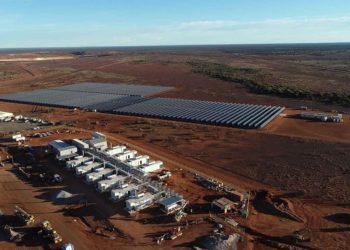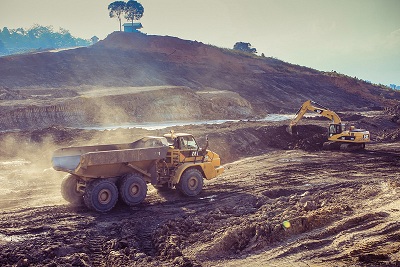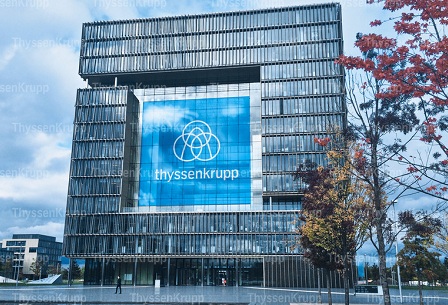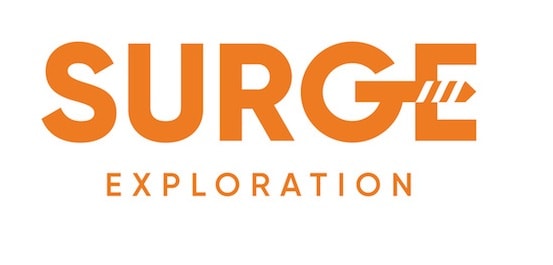A Major Drilling RC Schramm drill rig in operation at the Bronze Fox Copper Project during June.By John Miller, editor, The ASIA Miner
KINCORA Copper is adopting a common sense approach to surviving in difficult global economic conditions and to weathering the storm that has hit the mining industry in Mongolia. The Canadian-listed company is taking measured steps towards advancing its highly prospective Bronze Fox Copper Project in the prolific South Gobi region and this appears to be bearing fruit.
Kincora Copper’s Bronze Fox project is in the prolific South Gobi region of Mongolia, not far from the Chinese border.
The company’s president and CEO Sam Spring says that while there is definitely a need for caution in the current climate, particularly in Mongolia, explorers must continue to carry out their work in the quest to find another Oyu Tolgoi (OT) … and all the signs are encouraging for Kincora.
He says the company commenced a new drilling campaign in late May utilizing two diamond drill rigs and one RC rig. “We are testing targets defined since we last drilled in 2012 and are getting some good results. We have done a lot of long-lead time, technical work that in hindsight probably should have been done before the 2012 drilling as it has enabled us to better understand the targets.”
The current program has been designed to advance and test a number of large-scale copper porphyry targets focused at the West Kasulu, Sophie North and Leca Pass prospects, and a new target called Shargal Tolgoi (Yellowish Hill). Targets include the last hole drilled in December 2012, which returned localized copper of +4% on the periphery of a then untested IP chargeability high and in the western region, about 1km along strike, of previous drilling at West Kasulu in Shargal Tolgoi region.
Sam Spring says, “We were close to having something economic in 2012 and hopefully the 2014 work will help us solve the piece of the puzzle that was previously missing. We have been able to undertake this work because we had an oversubscribed raising in March. It wasn’t easy and about 66% of the $5 million raised came from new investors which is good in these tough global markets and even better considering Mongolia is particularly difficult.”
Investors are still prepared to consider Kincora, he says, because the money is going into the ground and into that stage of exploration where, if you have some success, they can ride the value curve.
“Technically, people understood some of the similarities in what we are looking to do and what Ivanhoe achieved at OT in 2001 that led to the discovery hole. There are no certainties as it is exploration but it is that part of the exploration cycle where success brings significant rewards.
“Unfortunately for most exploration companies in current markets with limited field season activities, the bulk of their remaining budget is spent on general and administrative (G&A) purposes, which does not add to shareholder value. We have compiled figures indicating that our G&A to exploration ratio is the highest in our peer group.”
A sandstorm approaching a camp site at Bronze Fox in May 2014.
Exploration focus
Sam Spring says there is no certainty of what exploration results will be but at least management and the Board are completely aligned with shareholders. “We are incentivized to generate good exploration results and try to maximize shareholder value in these difficult economic times. At the end of the day, when we went out to raise money this year that is what investors saw as the differentiating factor between us and a lot of our other peers and we are putting our money where our mouth is.
“$1.5 million of the $5 million came from insiders and were the first orders in the book – our two largest shareholders as well as Board and management.
“Our near-term focus is exploration and if we have some positive results that will dictate what the next course of action is. If we have a really good hole there is scope to ramp up the drilling program, which is what Ivanhoe did at OT. In the history of Bronze Fox, every hole drilled has returned at least lower grade copper, eg 0.1% to 0.3%, or higher.
“What we are trying to do now is refine the work done last year – the deeper and more extensive geophysics, induced polarization, alteration analysis, fertility analysis, etc. We believe the preliminary work last year and this year’s exploration will reduce the risk and increase our confidence in finding something that is higher grade and economic.”
To this end, initial results have been very encouraging, confirming the geological model, expanding the copper porphyry potential at Bronze Fox in the significant and new mineralized Shargal Tolgoi zone, and assisting to vector to interpreted high-grade and large tonnage potential.
One of a series of historic Soviet Union trenches dug across the West Kasuluoxide zone on the Bronze Fox licence. Outcropping malachite is visible.
Major miner onboard
Another positive for Kincora is that in the second quarter it entered into an agreement with a major miner focused on copper. Kincora has granted that company exclusive rights to carry out due diligence on Bronze Fox with respect to a potential joint venture, earn-in, strategic alliance, equity investment or other transaction. The agreement contemplates various work programs being undertaken during a staged review period in order to advance toward a potential transaction, and maintain certain exclusive rights to such a transaction and access to the properties/dataroom.
“Kincora is the last remaining listed copper junior in Mongolia without a strategic partner. This is despite Bronze Fox being one of the more advanced copper projects; situated in the OT mineralization structural trend; offering large-scale potential supported by known widespread lower grade copper mineralization, and localized higher grades; and strategically located. We have previously had a lot of interest in the project but one group going to that next level is positive, particularly given the global climate and most groups, including the majors, cutting back exploration,” Sam Spring says. “If nothing else, I am sure we will gain some valuable input into the technical understanding of the project from this experience and we are certainly not putting up a ‘for-sale’ sign.”
Kincora is also seeking to recover two licences revoked by the government last year that saw almost $7 million written off the company’s balance sheet. The company is actively lobbying the government, particularly as this dispute has far greater significance beyond just the impacted 106-licences, and the exploration sector/amended Minerals Law, with security of tenure, a transparent and consistent legal and legislative environment being key cornerstones for all private sector activities.
The cornerstone for Kincora is exploration results but at the same time it is looking at getting the exploration licences back, continuing corporate discussions and seeing what might happen with legislation in Mongolia. “If the moratorium on exploration licences is lifted I’d like to think that because we are the only junior really active in the OT copper belt and have been there longer than any other group, we have an excellent platform for potentially having more of a regional footprint,” he says.
Trenching in June 2014 at the Happy Geo prospect.Providing ‘bang for buck’
In these times mining companies have to reduce G&A and overheads, and Kincora is doing this through its budgets and Board realignment. “We took two members off the Board and added one in a bid to tighten things a little more,” Sam Spring says. “We are striving to ensure everyone in the team has a very focused role in adding value. Because we have some funds enabling us to do some exploration, we are in an excellent position in terms of getting maximum ‘bang for our buck’.
“When we went to tender for our current drilling program, we sought detailed tenders from five contractors we thought had the technical capacity to do the work required, being mindful of the fact that if we had some success we might require some deeper drilling capacity. Of the five companies we sought tenders from, there were more than 100 drill rigs available with not one of them in use or even in the pipeline of being used.
“Two of the five were international drillers and three were locally based. We chose Major Drilling, which is widely regarded as the leading drilling contractor in Mongolia in terms of experience, team and safety with current excess capacity in-country, having done a lot of work at OT. Indicative of the current exploration situation is that this year, for the first time, Major has had no work in Mongolia.
“We were lucky in that not only have we obtained a very competitive rate from Major compared to what they previously tendered us but we have their number one team, including the project manager who was previously working for Major at OT. Bronze Fox is only 140km away, in the same belt and with often the same aged and style of rocks, so having that kind of experience puts us in good stead. We are already seeing the benefits of this in drilling recovery rates and the professionalism of the team. Major was a little more expensive than the other tenders on headline rate per metre basis, but you get what you pay for and we believe the results are already demonstrating this. You can’t squeeze the supply chain too hard because at the end of the day it will come back to bite you.
“Last year although we didn’t drill, we probably spent the most amongst juniors on exploration in the copper space. We did 50sqkm of induced polarization that went down below 400 metres which was our previous limit and some areas went well below 1000 metres. We also did alteration analysis and some fertility analysis. I dare say our current drilling program along with our regional gold work, including some recently completed trenches for gold and copper, will be right up there in terms of work carried out this year.”
A Bronze Fox core sample showing quartz-sulphide veins with minor chalcopyrite.
New principal geologist
Kincora has recently appointed Henry Tebar as principal geologist and has also added a number of quality local geologists to its team. Henry Tebar has extensive copper and base metals exploration experience in various emerging and frontier countries, with proven porphyry ore body discovery experience. He is familiar with Bronze Fox via his previous role as president and chief geologist of the Trafigura-Origo Joint Venture in Mongolia, has extensive knowledge of various regional opportunities and has an existing working relationship with Kincora’s exploration director Yawen Cao.
“He will assist with the regional work because about 33% of previous drill holes at Bronze Fox have intersected at least 1.0 gram/tonne gold but we’ve never really had the resources to do a specific program.
The funds raised this year give us a unique position of being able to fund the program,” Sam Spring says.
Within Mongolia there are other companies doing work this year, including Xanadu and Erdene Resources, who weren’t very active last year. “Xanadu is drilling and Erdene has completed a program more focused on gold. We are starting to see positive signs from juniors in Mongolia after a frustrating and unproductive period. The coal price, and lack of rail infrastructure, means it is even tougher for coal companies operating and exploring in Mongolia.”
Facilities at the nearby Tsagaan Suvarga Copper Project of MAK.
Need for stable policy
The main message Kincora received during recent well attended roadshow sessions is that investors need to see a few things achieved by the Mongolian Government in order to attract significant capital.
“People need to see assurances from Mongolia before they are willing to part with any significant investment funds. We are seeing this caution affecting all projects, with OT underground expansion being the perfect example.
“Recently it has been difficult to get any sort of certainty in Mongolia and it seems as though you take one step forward on the back of perceived support but then the government makes a negative statement and you go three steps back,” Sam Spring states. “Late last year the government did some international roadshows with the common message being that it had learnt from past mistakes and would fix some of these issues, which made companies in the mining space feel a little more optimistic. More than six months later there haven’t been too many issues on that list fixed.”
Following this interview with Sam Spring and just before the spring session of parliament ended there were some positive moves from Mongolia with parliament voting to amend legislation governing mining activity by ratifying changes to the mining law of 2006. Among the changes will be expansion of Mongolia’s landmass open for exploration and subsequent mining activity, with 20% of the country set to be rated as available for development, rather than the 8% available previously.
The amendments will also see an end to the moratorium on new mineral exploration licences, imposed in 2010 as a means of cooling the rush into the sector at the time. Lifting the ban is intended to encourage a return to Mongolia by mining firms, as is the provision extending the term of exploration on a lease from nine years to 12. Detailed implementation policies are not yet available.
The amendments may also lead to resolution of the cancellation of 106 mining licences, with a specific resolution subsequently passed by government. The government took this measure last year as a result of a court case involving senior officials of the Mineral Resource Authority of Mongolia. Though the companies affected by the cancellation, including Kincora, were not directly involved in the investigation, the allegations of corruption against the officials were seen to have tainted many activities in the sector.
The flurry of last minute activity came amid Prime Minister Altankhuyag Norov’s 100-day push to jump start the economy after more than two years of slowing growth and plunging foreign investment. FDI fell 52% last year and dropped a further 70% in the first half of 2014, with the currency depreciating about 40% since the current Government took power and official inflation now increasing to 14.7%.
Sam Spring says these moves are positive but it remains to be seen what will happen when Parliament returns after the summer break. “If the reforms continue and other outstanding issues, such as the ongoing dispute over the OT expansion project, are resolved, then it will be good news for mining in Mongolia, although increased investment will take time to filter through – trust is not regained overnight.
“It is all about managing expectations and creating a legislative environment that is stable and productive for the private sector. There are a number of issues impacting the private sector in the mining space in Mongolia which means its potential isn’t being realized.
“Mining Minister Ganhuyag visited the PDAC convention in Canada in March and saw that Mongolia isn’t the only show in town – there are thousands of companies operating in different parts of the world all seeking funds but all fighting for the same investment dollar. He saw that there was a handful of Mongolian companies there seeking funds but which have one hand tied behind their backs because of what is happening politically. It is tough but Mongolia is still a relatively young democracy learning about free markets and it’s great to see the Minister taking that on board and reporting back to the government. Filtering through any legislative change in a fragmented parliament is difficult and while some of the key politicians get what is needed and realize what needs to happen, it is a democratic parliament of 76 members and it takes time.
The Tsagaan Suvarga repair shed with the open pit in the background.Potential still there “The potential for Mongolia is still there and we must hope that changes made just before Parliament ended the spring session are not altered or even rescinded. The ending of the moratorium on new exploration licences as well as the extension from nine to 12 years are very important for the future of mining in Mongolia. You aren’t going to have any new discoveries if you can’t explore, which in the end leads to an unsustainable future.”
Sam Spring says regional development is still occurring with the Tsagaan Suvarga (TS) copper molybdenum project of Mongolia’s third largest company, MAK, being an example. TS is 40km away from Bronze Fox. “As well as TS, privately-owned MAK is into construction, operates Hunnu Airlines and a number of coal producing assets. MAK has spent more than $300 million on construction of TS but work was halted late last year with the company seeking ways to fund completion.
“OT stage one is ramping up and many coal operations are still producing although margins are quite skinny. What many people don’t realize is that, despite Mongolia’s challenges, the South Gobi is one of the world’s most rapidly emerging infrastructure and mining hubs. It is also still well placed to serve China, which is still growing – our project is only 250km away while OT is only 140km from the border.
China is still building new copper smelters and demand for copper outside the current oversupply scenario, is looking quite good.
“Where in the world is there another underexplored frontier that has multi-billion dollar greenfield projects being built in about a three year period – OT, Tavan Tolgoi and TS? You wouldn’t see it in Chile and you don’t see it in Canada or in Australia. This illustrates the potential of Mongolia. You obviously need legislative stability and the right framework from a macro and a Mongolian legislative perspective.”
Sam Spring says that copper is not like coal where it usually just sticks out of the ground and you stub your toe on it – you need systematic exploration. “Have a look at what Cameron McRae, previous CEO of OT, says, what Robert Friedland has been saying, what Turquoise Hill Resources says – everyone thinks there are other copper discoveries, other OTs, out there to be made but no one is doing the work.
There is potential and the rocks certainly aren’t changing.”








